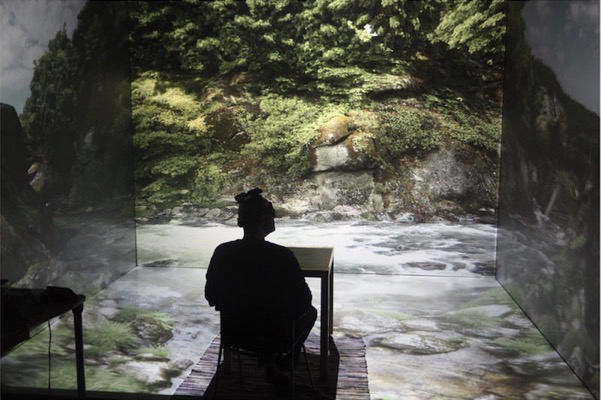Audio is a key aspect of virtual and augmented realities, however, because of the dominance of the visual sense, it is often overlooked, under-budgeted and considered at a late stage in the creation of healthcare and other applications. This article seeks to raise awareness for the importance of high-quality audio in healthcare applications by showing how noise and distortions can have adverse effects on patient recovery.

Nature views and sounds in Healthcare
Medical procedures are often associated with discomfort, pain and anxiety. Studies have shown that pain during treatment can be reduced by watching nature scenes [1], listening to nature sounds [2] or escaping into immersive virtual environments [3]. A view of a garden can improve postoperative recovery as well as reduce the amount of analgesics taken by patients [2], however if windows are not available, even sounds and sights of nature displayed on a bedside curtain have been shown to be useful to distract patients from the unpleasant side-effects of flexible bronchoscopy, a medical procedure that can cause a lot of discomfort, pain, and anxiety in patients [1]. And there is more evidence that music and sounds can be used very successfully in health care applications.
A 2011 study for example, showed that playing soothing music to post-operative cardiac surgery patients significantly reduced pain pf the patients [4]. The study included 100 patients of which 49 patients were administered a music condition and the remaining 51 patients received standard care with a quiet resting period. Results show that the music group experienced significantly reduced levels of pain. Furthermore, anxiety levels were reduced and level of relaxation as well as overall satisfaction of patients increased dramatically.

Music Therapy for Healthcare
Not only can postoperative patients benefit from listening to soothing music. Music therapy has also been found to significantly reduce stress and postnatal depression in pregnant women [5]. Another study [6] describes a large number of applications where music and access to nature are used successfully in hospital settings to reduce stress and pain as well as improve patient sleep and recovery. As early as 1978 there were studies that describe the positive effects of using music therapy in palliative care [7]. The researchers conclude that “music therapy has made a significant contribution to a wide variety of palliative care problems”.
Another study [8] used pure nature sounds instead of soothing music. In his study he investigated the influence of listening to ocean sounds on the night sleep pattern of postoperative coronary artery bypass graft patients after they were transferred from an intensive care unit. Findings showed significantly improved scores for sleep depth, awakening, return to sleep, quality of sleep, and total sleep scores for the group that received the ocean sound treatment. Ocean sounds are also used successfully to help patients suffering from tinnitus [9]. Further evidence for the usefulness of nature sounds in healthcare applications comes from a study that presented 40 subjects with sounds from nature (a mixture of sounds from a fountain and tweeting birds) or noisy urban environments (road traffic noise) after a stressful mental arithmetic task [10].
Unsurprisingly, the results of these investigations suggest that psychological stress and physiological recovery of the sympathetic nervous system is faster during exposure to pleasant nature sounds than to the unpleasant city noises. [11] made the same observation with stressed individuals using visual stimuli (instead of sounds) from nature and urban environments. Those patients who were presented with views of nature experienced a reduction in stress whereas those patients who looked at the urban scenes experienced a significant increase in sadness. Apart from reducing stress, exposure to nature also significantly reduced fear arousal.

Virtual Reality in Healthcare
Lastly, our recent review of the article inducing physiological stress recovery with sounds of nature in a virtual reality forest further shows the beneficial effect of combining soothing sights and sounds of nature in a virtual environment. From this and the evidence above it is clear that the positive effects of nature sounds and sights as well as music on patients’ well-being and recovery are well established. For those who require professional virtual relaxation environments with high-quality nature sounds that are combined with soothing music by established meditation music composers, our Atmosphaeres may present a uniquely effective way to reduce pain, anxiety and stress. For those who seek the pure sounds of nature, the Dream Waves album from our sister site feeltherelaxation.com is likely to yield very good results for sleeping disorders.
Scientific References:
[1] Diette, G. B., Lechtzin, N., Haponik, E., Devrotes, A., & Rubin, H. R. (2003). Distraction therapy with nature sights and sounds reduces pain during flexible bronchoscopy. Chest, 123(3), 941-948. doi:10.1378/chest.123.3.941
[2] Ulrich, R. S. (1984). View through a window may influence recovery from surgery. Science, 224(4647), 420-1
[3] Hoffman, H. G., Richards, T. L., Bills, A. R., Van Oostrom, T., Magula, J., Seibel, E. J., & Sharar, S. R. (2006). Using fmri to study the neural correlates of virtual reality analgesia. CNS Spectr, 11(1), 45-51.
Hoffman, H. G., Chambers, G. T., Meyer, W. J., Arceneaux, L. L., Russell, W. J., Seibel, E. J., . . . Patterson, D. R. (2011). Virtual reality as an adjunctive non-pharmacologic analgesic for acute burn pain during medical procedures. Ann Behav Med, 41(2), 183-91. doi:10.1007/s12160-010-9248-7
[4] Cutshall, S. A., Anderson, P. G., Prinsen, S. K., Wentworth, L. J., Olney, T. J., Messner, P. K., . . . Bauer, B. A. (2011). Effect of the combination of music and nature sounds on pain and anxiety in cardiac surgical patients: A randomized study. Altern Ther Health Med, 17(4), 16-23
[5] Chang, M. -Y., Chen, C. -H., & Huang, K. -F. (2008). Effects of music therapy on psychological health of women during pregnancy. Journal of Clinical Nursing, 17(19), 2580-2587. doi:10.1111/j.1365-2702.2007.02064.x
[6] Shepley, M. M. (2006). The role of positive distraction in neonatal intensive care unit settings. Journal of Perinatology, 26, S34-S37
[7] Munro, S., & Mount, B. (1978). Music therapy in palliative care. Can Med Assoc J, 119(9), 1029-34
[8] Williamson, J. W. (1992). The effects of ocean sounds on sleep after coronary artery bypass graft surgery. Am J Crit Care, 1(1), 91-7
[9] Hobson, J., Chisholm, E., & El Refaie, A. (2012). Sound therapy (masking) in the management of tinnitus in adults. Cochrane Database Syst Rev, 11, CD006371. doi:10.1002/14651858.CD006371.pub3
[10] Alvarsson, J. J., Wiens, S., Nilsson, M. E., Alvarsson, J. J., Wiens, S., & Nilsson, M. E. (2010). Stress recovery during exposure to nature sound and environmental noise. International Journal of Environmental Research and Public Health, 7(3), 1036-1046. doi:10.3390/ijerph703103
[11] Ulrich, R. S. (1979). Visual landscapes and psychological well-being. Landscape Research, 4(1), 17-23
 RSS - Posts
RSS - Posts
Leave a Reply